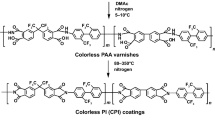A method has been developed for securing an optical fiber in a quartz connector by using sodium polysilicate hydrogel formed in a cylindrical gap between a connector and an optical fiber by means of alkaline decomposition of the quartz surfaces of manufactured components. The conditions for the thermal decomposition of hydrogel are determined, and it is shown that hydrogel decomposition with cellular structure formation is possible at temperatures below the thermal decomposition temperature of the polymer coating of the optical fiber. The hydrogel formation conditions and the thermal properties of the hydrogel are determined. Conclusions regarding the suitability of the proposed method for securing an optical fiber in a quartz connector are drawn.






Similar content being viewed by others
References
K. Shikama and Y. Koike, “Reflowable optical connector with glass-ceramic ferrule for advanced pluggable transceiver packaging,” Opt. Fiber Technol., No. 54, 102074 (2020).
W. Wang, W. Wu, S. Wu, et al., “Adhesive-free bonding homogenous fused-silica Fabry–Perot optical fiber low pressure sensor in harsh environments by CO2laser welding,” Opt. Commun., No. 435, 97 – 101 (2019).
W. Wang, X. Zhou, W. Wu, et al., “Monolithic structure-optical fiber sensor with temperature compensation for pressure measurement,” Materials, No. 12, 552 (2019).
E. A. Mamchenkov and V. Yu. Prokofiev, “Preparation of sodium silicate from modified silica gel, by-product of aluminum fluoride,” Izv. Univ. Chemistry Chem. Technol., 62(3), 89 – 93 (2019).
G. Du, S. Zheng, and H. Ding, “Process optimization of the reaction of acid leaching residue of asbestos tailing and sodium hydroxide aqueous solution,” Sci. China, Ser. E: Technol. Sci., No. 52(1), 204 – 209 (2009).
A. Bajza, I. Rouseková, and V. Živica, “Silica fume–sodium hydroxide binding systems,” Cement Concrete Res., No. 28(1), 13 – 18 (1998).
I. Vaisman, A. Ketov, and I. Ketov, “Cellular glass obtained from non-powder preforms by foaming with steam,” Ceram. Int., No. 42, 15261 – 15268 (2016).
E. A. Yatsenko, V. A. Smoliy, L. V. Klimova, et al., “Foam glass synthesis by a hydrate method based on various natural materials,” Glass Ceram., 93(4), 19 – 24 (2020).
V. I. Korneev and V. V. Danilov, Soluble and Liquid Glass [in Russian], Stroiizdat, St. Petersburg (1996).
A. Baliñski, “The influence of silica module of the soluble sodium silicate hardened by ester on the residual strength of molding sand,” Arch. Foundry Eng., No. 13(1), 131 – 133 (2013).
Ya. I. Vaisman, Yu. A. Ketov, V. S. Korzanov, and M. P. Krasnovskikh, “Aspects of the chemistry of gas formation during the one-stage synthesis of foam glass from sodium hydroxide and sodium nitrate,” Constr. Mater., No. 11, 64 – 67 (2018).
Author information
Authors and Affiliations
Corresponding author
Additional information
Translated from Steklo i Keramika, No. 11, pp. 47 – 52, November, 2023.
Rights and permissions
Springer Nature or its licensor (e.g. a society or other partner) holds exclusive rights to this article under a publishing agreement with the author(s) or other rightsholder(s); author self-archiving of the accepted manuscript version of this article is solely governed by the terms of such publishing agreement and applicable law.
About this article
Cite this article
Zhikina, L.A., Minkin, A.M., Krasnovskikh, M.P. et al. Hydrogel Assisted Optical Fiber Attachment in a Connector. Glass Ceram 80, 487–490 (2024). https://doi.org/10.1007/s10717-024-00638-5
Received:
Published:
Issue Date:
DOI: https://doi.org/10.1007/s10717-024-00638-5




